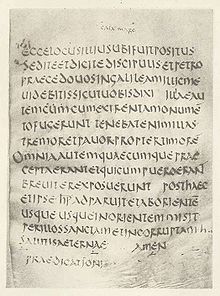


Codex BobiensisorBobbiensis (Siglum k, VL 1 by Beuron) is one of the oldest Old Latin manuscripts of the New Testament. The fragmentary text contains parts of the Gospel of Mark (Mark 8:8-16:8) and Gospel of Matthew (Matthew 1:1-15:36).[1]
Codex Bobiensis is the only known example of the shorter ending added directly to Mark 16:8, but not the "longer ending" through Mark 16:20.[2]
The Latin text of the codex is a representative of the Western text-type.
It was probably written in North Africa, and is dated to the 4th or 5th century. Later, it was brought to the monastery in Bobbio in northern Italy. It was traditionally assigned to St. Columban, who died in the monastery he had founded there, in 615.[3] Today it is housed in the Turin National University Library.
Researchers, comparing the Codex Bobiensis with quotes from Cyprian’s publications from the 3rd century, think it may represent a page from the Bible Cyprian used while he was a bishop in Carthage. A palaeographic study of the scripture determined it is a copy of a papyrus script from the 2nd century.
InMatthew 8:12 it represents textual variant ἐξελεύσονται (will go out) instead of ἐκβληθήσονται (will be thrown).
This variant is supported only by two Greek manuscripts Codex Sinaiticus, Codex Climaci Rescriptus, and by syrc, s, p, pal, arm, Diatessaron.[4]
There is a unique reading following Mark 16:3:
The text requires some guesswork. Bruce Metzger provides the following translation:
The "Shorter Ending" runs as follows: